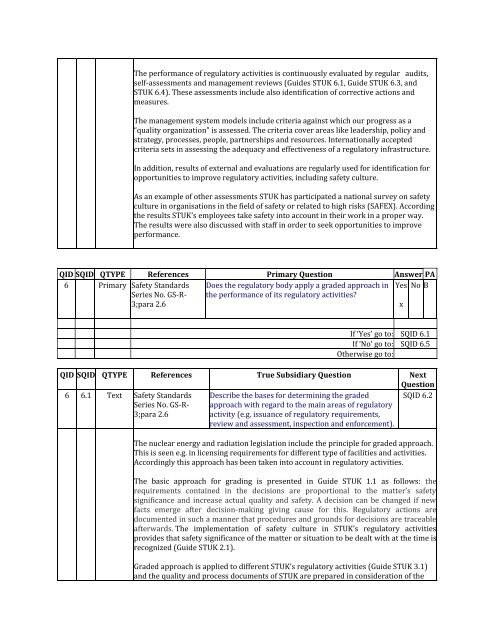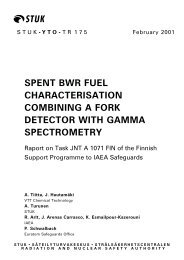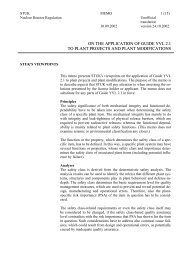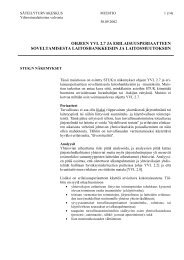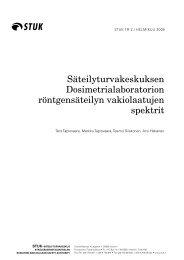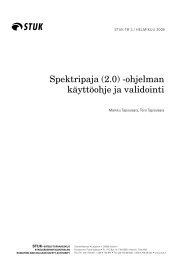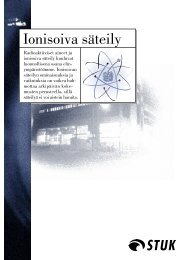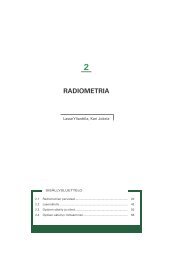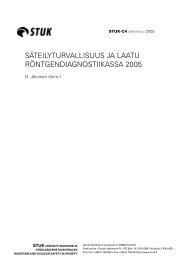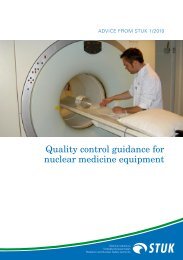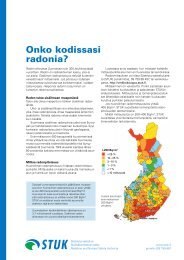Core Questions (GSR Part 1 and GS-R-3) Primary Module ... - STUK
Core Questions (GSR Part 1 and GS-R-3) Primary Module ... - STUK
Core Questions (GSR Part 1 and GS-R-3) Primary Module ... - STUK
You also want an ePaper? Increase the reach of your titles
YUMPU automatically turns print PDFs into web optimized ePapers that Google loves.
The performance of regulatory activities is continuously evaluated by regular audits,<br />
self-assessments <strong>and</strong> management reviews (Guides <strong>STUK</strong> 6.1, Guide <strong>STUK</strong> 6.3, <strong>and</strong><br />
<strong>STUK</strong> 6.4). These assessments include also identification of corrective actions <strong>and</strong><br />
measures.<br />
The management system models include criteria against which our progress as a<br />
“quality organization” is assessed. The criteria cover areas like leadership, policy <strong>and</strong><br />
strategy, processes, people, partnerships <strong>and</strong> resources. Internationally accepted<br />
criteria sets in assessing the adequacy <strong>and</strong> effectiveness of a regulatory infrastructure.<br />
In addition, results of external <strong>and</strong> evaluations are regularly used for identification for<br />
opportunities to improve regulatory activities, including safety culture.<br />
As an example of other assessments <strong>STUK</strong> has participated a national survey on safety<br />
culture in organisations in the field of safety or related to high risks (SAFEX). According<br />
the results <strong>STUK</strong>’s employees take safety into account in their work in a proper way.<br />
The results were also discussed with staff in order to seek opportunities to improve<br />
performance.<br />
QID SQID QTYPE References <strong>Primary</strong> Question Answer PA<br />
6 <strong>Primary</strong> Safety St<strong>and</strong>ards<br />
Series No. <strong>GS</strong>-R-<br />
3;para 2.6<br />
Does the regulatory body apply a graded approach in<br />
the performance of its regulatory activities?<br />
Yes No B<br />
x<br />
If ‘Yes’ go to: SQID 6.1<br />
If ‘No’ go to: SQID 6.5<br />
Otherwise go to:<br />
QID SQID QTYPE References True Subsidiary Question Next<br />
Question<br />
6 6.1 Text Safety St<strong>and</strong>ards<br />
Series No. <strong>GS</strong>-R-<br />
3;para 2.6<br />
Describe the bases for determining the graded<br />
approach with regard to the main areas of regulatory<br />
activity (e.g. issuance of regulatory requirements,<br />
review <strong>and</strong> assessment, inspection <strong>and</strong> enforcement).<br />
SQID 6.2<br />
The nuclear energy <strong>and</strong> radiation legislation include the principle for graded approach.<br />
This is seen e.g. in licensing requirements for different type of facilities <strong>and</strong> activities.<br />
Accordingly this approach has been taken into account in regulatory activities.<br />
The basic approach for grading is presented in Guide <strong>STUK</strong> 1.1 as follows: the<br />
requirements contained in the decisions are proportional to the matter’s safety<br />
significance <strong>and</strong> increase actual quality <strong>and</strong> safety. A decision can be changed if new<br />
facts emerge after decision-making giving cause for this. Regulatory actions are<br />
documented in such a manner that procedures <strong>and</strong> grounds for decisions are traceable<br />
afterwards. The implementation of safety culture in <strong>STUK</strong>’s regulatory activities<br />
provides that safety significance of the matter or situation to be dealt with at the time is<br />
recognized (Guide <strong>STUK</strong> 2.1).<br />
Graded approach is applied to different <strong>STUK</strong>’s regulatory activities (Guide <strong>STUK</strong> 3.1)<br />
<strong>and</strong> the quality <strong>and</strong> process documents of <strong>STUK</strong> are prepared in consideration of the


